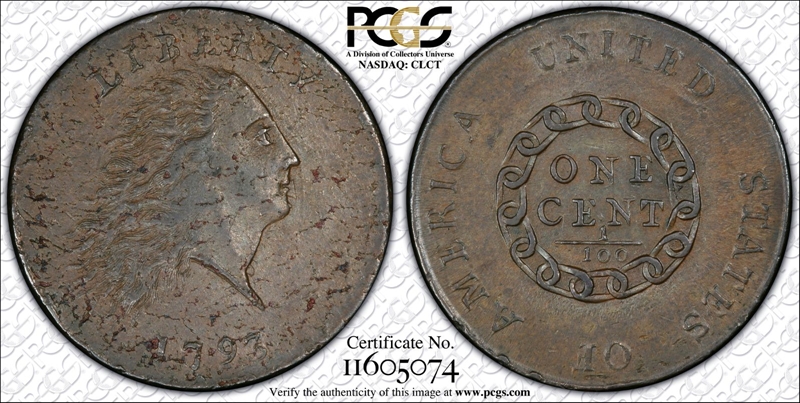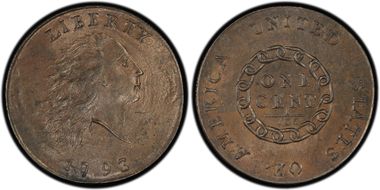1793 1C Chain, America, BN AU53BN 认证号11605074, PCGS号1341
拥有者评论
1793 Chain 1C AMERICA AU53. S-3, B-4, Low R.3. EAC 40. Surfaces: The obverse surface has countless minute defects that appear to be almost entirely planchet flaws, representing an improperly refined strip of copper, a common problem in the first year of Mint operations. Sheet copper was not yet available from England, so available copper was scrap copper from local sources that Henry Voigt acquired. In his Encyclopedia of Large Cents, Breen discussed the problems with this locally available copper: "Scrap copper varied greatly in homogeneity, density, malleability, and hardness. This is partly from different trace elements and partly from the way the individual lumps had been treated in manufacture. This was a most unsatisfactory expedient; the coiner's department learned quickly that different ingots cast from it varied greatly , with far too many gas bubbles. Strip rolled from these ingots came out with too many cavities and laminations. Many surviving Chain cents accordingly show such flaws." The sophisticated collector will appreciate the planchet flaws as part of this coin's history and charm. A few tiny rim bumps are visible, and these appear to be the only post-strike imperfections. In direct opposition to the obverse, the reverse surface is nearly flawless. Only a few minute defects, rim flaws, and abrasions can be seen. Both sides have lovely medium brown color with traces of darker steel color on the high points. Considerable original mint frost remains, with splashes of lighter tan on the reverse, faded from original mint red. This example is a later die state. The obverse has prominent clash marks around and below the bust, and the reverse is flowlined with field roughening below UNITED STATES. The latest known die state of this variety, called Die State III in Breen's classification, displays heavy clash marks along Liberty's lips, chin, neck, and bust line. Breen suggested that these obverse clash marks, as seen somewhat on this example, were responsible for the "Liberty in chains epithet" sometimes given to the Chain cents. The Chain design was intended to show strength or unity of our new nation. Instead, the device was interpreted by many as representing slavery. Most of the mintage was lost or destroyed, so survivors are of various grades, usually lower quality. Porous or corroded pieces are frequently encountered. There is no question among specialists that Sheldon-3 is the most common Chain cent. Current rarity ratings for the Chain cent varieties suggest that the total surviving population of all varieties is 900 to 1,000 coins, with 400 to 500 examples of the S-3 and about 500 to 600 of all other varieties combined. Working under the assumption that the current rarity ratings are reasonably accurate, we can surmise that the original mintage occurred in about the same proportion. Approximately 18,000 examples of this die marriage were coined, with another 18,000 of the other three Sheldon numbers.
专家评论
David Hall
The incredible SP67 is from the fabulous large cent collection of the late Ted Naftzger, the greatest large cent collection of all-time by far. This amazing coin has semi-prooflike surfaces and is virtually perfect. Large cent affcianados refer to this amazing specimen as "THE coin."
Gordon Wrubel
Chain cents were the first mass produced, regular issue coins struck at the fledgling US Mint. A total of 36,103 were coined from February 27 to March 12, 1793. The Liberty Head obverse and Chain reverse were severely criticized by many observers of the day. The acute need for a standard coinage, however, assured wide circulation through all fifteen States at the time. Chain cents can exist in high Mint State grades, perhaps saved for posterity as first year issues. But most survivors are lower grade. In the lowest grades, the date and legends are sometimes worn to the point where little more than the Chain and some of the letters of "ONE CENT" within it are distinguishable. This makes variety attribution extremely difficult, if not impossible, in cases where just a shadow of the Chain exists.Quickfinder Notes: AMERICA reverse varieties include Sheldon numbers 2, NC-1, 3 and 4. Well worn can be attributed even if most or all of the letters of AMERICA are missing. The baseline "C" in "CENT" will be a little ABOVE the baseline of the adjacent E. If the first A in AMERICA is distinguishable, it will be in the 7:30 position. On the other reverse die used on Chain cents, the Sheldon 1, "AMERI.", the baseline of the C in CENT is BELOW the baseline of the adjacent E. If the A of AMERI is distinguishable, it will be in the 8:00 position.
PCGS #
1341
设计师
Attributed to Henry Voight
边缘
Bars and Vines
直径
27.00 毫米
重量
13.48 克
铸币数量
36103
金属成分
Copper
更高评级数量
22
评级较低的钱币数量
505
地区
The United States of America
价格指南
PCGS 数量报告
拍卖 - PCGS 评级的
拍卖 - NGC 评级的
稀有性和存量估计 了解更多
| 所有评级 | 625 |
| 60或以上 | 6 |
| 65或以上 | 1 |
| 所有评级 | R-5.7 |
| 60或以上 | R-9.7 |
| 65或以上 | R-10.0 |
| 所有评级 | 3 / 3 |
| 60或以上 | 3 / 3 |
| 65或以上 | 1 / 3 TIE |
| 所有评级 | 3 / 3 |
| 60或以上 | 3 / 3 |
| 65或以上 | 1 / 3 TIE |





















